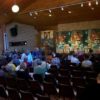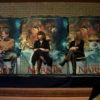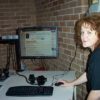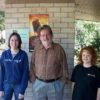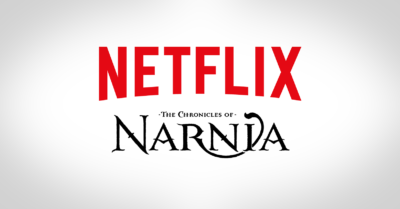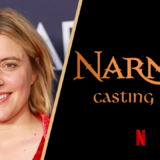Report: CS Lewis Conference – Day 3
NarniaWeb Moderators ‘Dooby’ and ‘Coracle’ attended the CS Lewis Conference in Australia this week and had the chance to hear Narnia cinematographer Don McAlpine and makeup artist Tracey Reeby. At the conference, it was reinstated that Prince Caspian, Voyage of the Dawn Treader, and The Silver Chair may be filmed very close to one another in a “Caspian” trilogy of sorts. And, production designer Roger Ford is already working on ‘Prince Caspian’.
- Booke Table at the CSL Conference
- Stage at CSL Conference
- Speakers at CSL Conference
- Reebey and ‘Coracle’
- Coracle on Narniaweb!
- Dooby, McAlpine and Coracle
UPDATE: Read Coracle’s report here.
Here is Dooby’s report:
C.S. Lewis Conference: Day 3
Coracle and I were able to attend the last day of the C.S. Lewis Today conference in Sydney, and thoroughly enjoyed it! As well as the film session, we were fortunate to hear a number of interesting talks and panels about Lewis. Unfortunately, Douglas Gresham (Lewis’ stepson, and executive producer on the film) was ill on the day and couldn’t attend (although his son stepped in to do a book signing on his behalf!).
A lot of interesting things were discussed by Narnia cinematographer Don McAlpine and makeup artist/hairstylist Tracey Reebey. Tracey had been a fan of the book since she was 9 years old but Don only read it after seeing the film. He wanted to create his images from the script so they would be synonymous with the overall vision of the film.
Both were full of praise for Doug Gresham’s involvement, saying how he was there for the small design issues and how he was always giving support and praise on the set. Despite being executive producer, he went around and personally thanked the most minor of staff working on the film.
Tracey said that the cherry blossom dryad was filmed with a real actress wearing a wig (with markers attached to her) who was then filmed in order to make the dryad look as human as possible. The benchmark technical advances were among the things that attracted Tracey and Don to working on the film. Tracey noted that even as a makeup artist, it was impossible for her to pick the merger between makeup and CG. Don commented that the CG lion hair alone cost about 10 million dollars to render, adding that “the computers are still cooling down”. A story was told about Doug being asked how he got permission to get “real” polar bears into New Zealand!
Tracey then talked about how the prosthetics for the characters such as Tumnus couldn’t be re-used and had to be moulded every day, as well as the individual hairs being laid on rather than using a wig. 165 makeup artists worked on Narnia, and they had to keep photos and take note of every character, especially as some appliances took 6-8 weeks to produce.
When Don was asked how the weather was in New Zealand, he replied, “Fine, about six times a day!” Tracey said that it was really hard to apply and maintain makeup over 10-12 hours a day for 46 days of intense location shooting (as well as establishing continuity over an 8-month period). Even if the makeup wasn’t as perfect as they would have liked at any given moment, they had to rush out and shoot if the weather changed for the better.
A lot of emphasis was placed on making Narnia feel real rather than like a fantasy world. Don said that this was contributed to by the camera positioning and angles, which were kept fairly straightforward for a naturalistic although slightly heightened sense of reality. Producing a timeless look for the film was also important. Tracey talked about how a period look was needed for the London scenes in terms of costume and hair, but the look for Narnia had to be as applicable in 20 years time as it is now. This extended to the choice of hairstyle for the Witch (dreadlocks).
Don talked specifically about why several changes were made to the story. The opening scenes in London were added to skew audience expectations and begin with an exciting and involving scene, as well as establishing proper relationships with the characters rather than having four relative strangers entering Narnia fairly quickly.
He then discussed the waterfall scene, saying that it was a real miracle that they got it finished since they had a hard time figuring out how they were going to get it right! It needed to establish Peter as a neutral character while giving hints of his eventually taking on the mantle of king, easing us into accepting him through his reacting rather than acting. They also felt that the audience needed to experience some energy at that point. An interesting and ironic piece of trivia: some of the waterfall scenes were shot in Prague in a studio that was built for Hitler in 1942 for his Nazi propaganda films. Don said that a small, very fast CG team in Costa Rica worked on some scenes for the waterfall sequence, even adding the frosty breath of the characters.
Someone remarked that some people find Aslan is less majestic and central in the film than they expected. Don explained that Aslan was deliberately played down slightly because it gave him more power and pathos than if he had come across as a very strong, omnipotent character. Tracey added that this gives him room to develop over the course of the rest of the films rather than giving him no room to grow as a character.
Another person asked why the children argued more in the film than in the book, and why Peter wasn’t as eager about becoming king. The consensus was that this (along with some updated dialogue) contemporised the children for modern audiences, and captured a realistic family dynamic while helping children to still understand the 1940s. As for Peter, the panellists agreed that this was to provide room for his development as king in Prince Caspian.
Tracey and Don talked a bit about the actors, saying that Tilda completely took on the role of the Witch, and was a very down-to-earth person, even coming up to the set on her days off and hanging around and keeping things relaxed. They were full of praise for the children, especially Georgie, whom they described as an extremely intelligent 9-year-old. They added that there could have been a few qualms when there was still some time left to film if Georgie had decided that she was tired and wanted to go home and didn’t want to finish shooting (luckily she did finish!).
It was reinstated that Prince Caspian, Voyage of the Dawn Treader, and The Silver Chair may be filmed very close to one another in a “Caspian” trilogy of sorts. It was revealed that one of the main reasons that the BBC didn’t finish their production of the series was that those children had grown too fast, so they want to avoid the same thing happening with the Walden productions.
Finally, production designer Roger Ford is reportedly currently working on Prince Caspian. No locations have been fully decided on as of yet, but countries being touted for various locations include Ireland, New Zealand, and now Malta. It’s thought that at least part of the film is likely to be shot in New Zealand.


